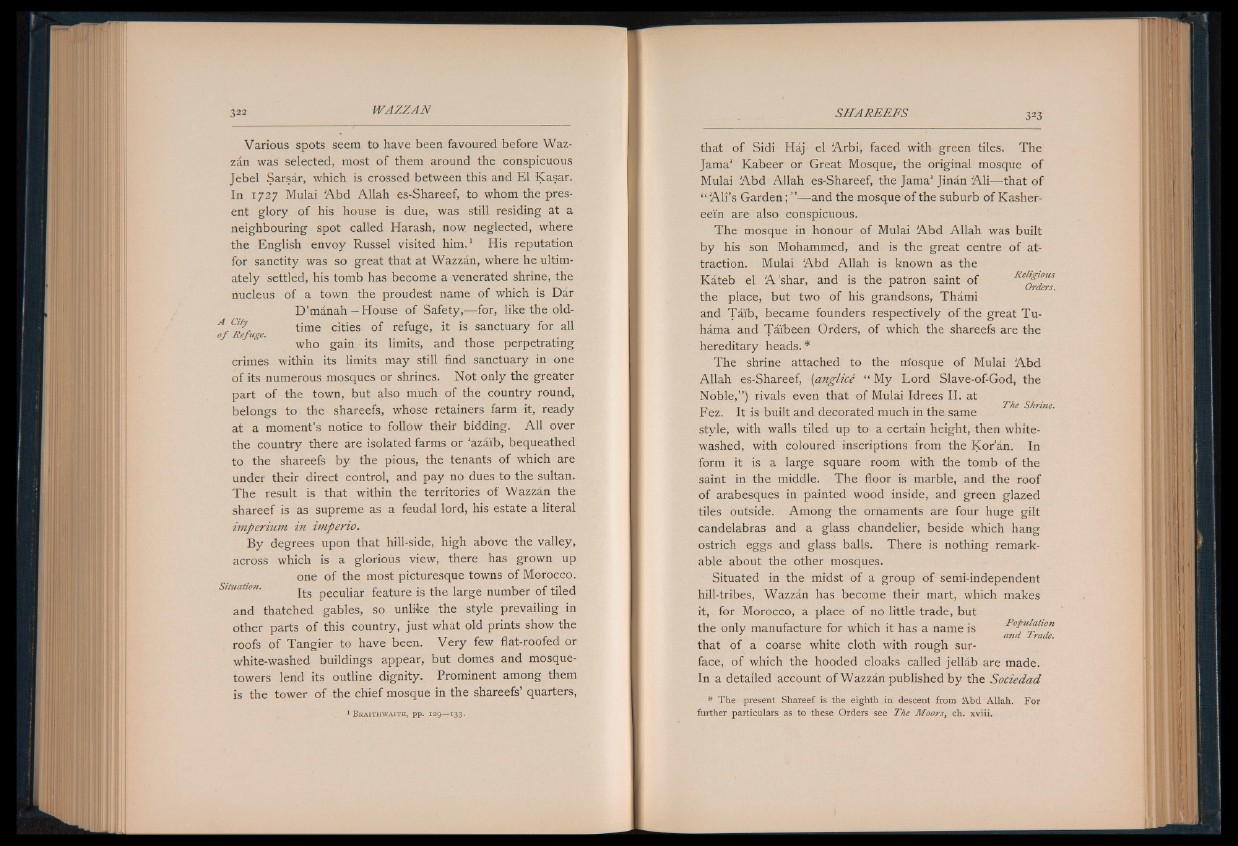
Various spots seem to have been favoured before Wazzan
was selected, most of them around the conspicuous
Jebel Sarsar, which is crossed between this and El Kasar.
In 1727 Mulai Abd Allah es-Shareef, to whom the present
glory of his house is due, was still residing at a
neighbouring spot called Harash, now neglected, where
the English envoy Russel visited him.1 His reputation
for sanctity was so great that at Wazzan, where he ultimately
settled, his tomb has become a venerated shrine, the
nucleus of a town the proudest name of which is Dar
D ’manah—House of Safety,— for, like the old-
„ time cities of refuge, it is sanctuary for all
o f Refuge. 0 .
who gain, its limits, and those perpetrating
crimes within its limits may still find sanctuary in one
of its numerous mosques or shrines. Not only the greater
part of the town, but also much of the country round,
belongs to the shareefs, whose retainers farm it, ready
at a moment’s notice to follow their bidding. All over
the country there are isolated farms or ‘azai'b, bequeathed
to the shareefs by the pious, the tenants of which are
under their direct control, and pay no dues to the sultan.
The result is that within the territories of Wazzan the
shareef is as supreme as a feudal lord, his estate a literal
imperium in imperio.
By degrees upon that hill-side, high above the valley,
across which is a glorious view, there has grown up
one of the most picturesque towns of Morocco.
Its peculiar feature is the large number of tiled
and thatched gables, so unlike the style prevailing in
other parts of this country, just what old prints show the
roofs of Tangier to have been. Very few flat-roofed or
white-washed buildings appear, but domes and mosque-
towers lend its outline dignity. Prominent among them
is the tower of the chief mosque in the shareefs’ quarters,
* B r a i t h w a i t e , p p . 129— 13 3 .
that of Sidi Haj el Arbi, faced with green tiles. The
Jama1 Kabeer or Great Mosque, the original mosque of
Mulai Abd Allah es-Shareef, the Jama1 Jinan A li— that of
“ A ll’s Garden; ”— and the mosque of the suburb of Kasher-
eei'n are also conspicuous.
The mosque in honour of Mulai A b d Allah was built
by his son Mohammed, and is the great centre o f attraction.
Mulai Abd Allah is known as the
Kateb el A'shar, and is the patron saint of Religious
A Orders.
the place, but two of his grandsons, Thami
and Taib, became founders respectively of the great Tuhama
and Taibeen Orders, of which the shareefs are the
hereditary heads.*
The shrine attached to the m’osque of Mulai Abd
Allah es-Shareef, (anglice “ My Lord Slave-of-God, the
Noble,” ) rivals even that of Mulai Idrees II. at
. The Shrine. Fez. It is built and decorated much in the same
style, with walls tiled up to a certain height, then whitewashed,
with coloured inscriptions from the Kor'an. In
form it is a large square room with the tomb of the
saint in the middle. The floor is marble, and the roof
of arabesques in painted wood inside, and green glazed
tiles outside. Among the ornaments are four huge gilt
candelabras and a glass chandelier, beside which hang
ostrich eggs and glass balls. There is nothing remarkable
about the other mosques.
Situated in the midst of a group of semi-independent
hill-tribes, Wazzan has become their mart, which makes
it, for Morocco, a place of no little trade, but
the only manufacture for which it has a name is Population
' % ^ and Irade.
that of a coarse white cloth with rough surface,
of which the hooded cloaks called jellab are made.
In a detailed account of Wazzan published by the Sociedad
* The present Shareef is the eighth in descent from Abd Allah. For
further particulars as to these Orders see The Moors, ch. xviii.